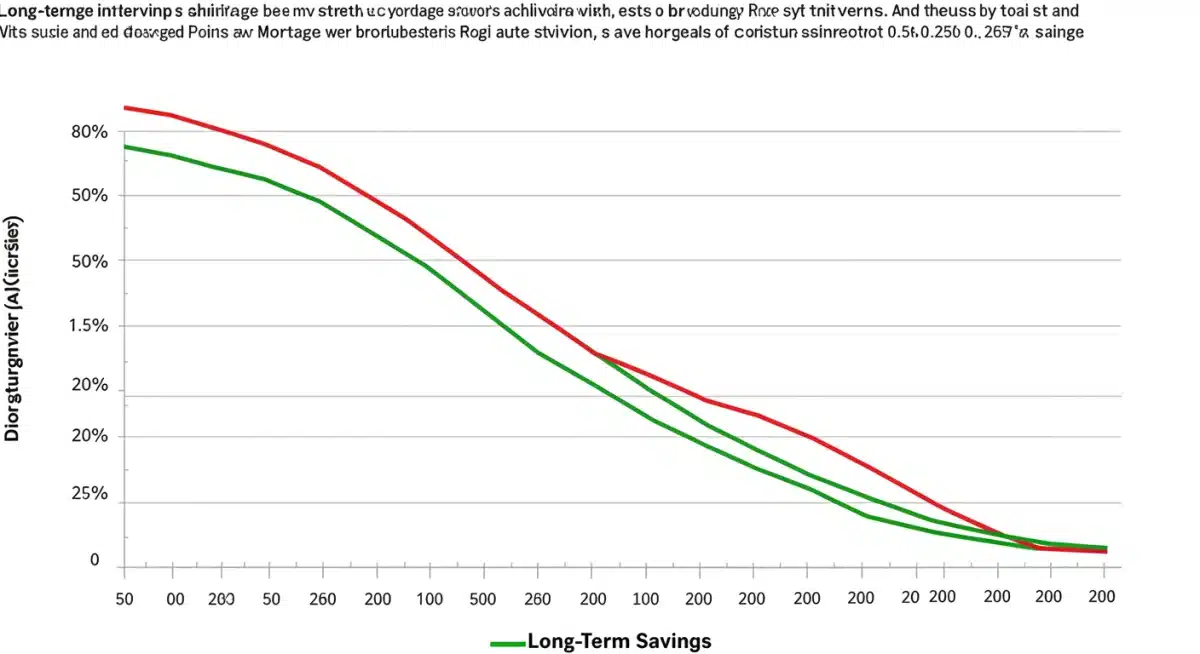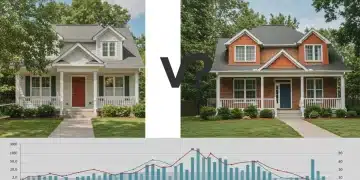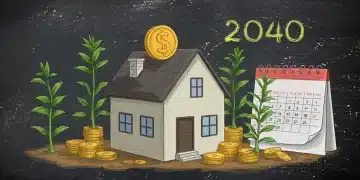Understanding Mortgage Points 2025: Buying Down Your Rate by 0.25% for Long-Term Savings

Understanding mortgage points in 2025 is crucial for homebuyers seeking long-term savings; strategically paying points to reduce your interest rate by 0.25% can significantly lower monthly payments and overall loan costs, optimizing your home financing strategy.
As the housing market continues to evolve, Understanding Mortgage Points 2025: Buying Down Your Rate by 0.25% for Long-Term Savings has become a critical topic for prospective homeowners. This strategy can significantly impact your financial future, offering a pathway to substantial savings over the life of your loan.
What Are Mortgage Points and How Do They Work?
Mortgage points, also known as discount points, are essentially prepaid interest paid to your lender at closing in exchange for a lower interest rate on your home loan. Each point typically costs 1% of the loan amount and reduces your interest rate by a certain fraction, often 0.25% per point, though this can vary by lender and market conditions. For 2025, experts anticipate a continued focus on these tools as buyers navigate fluctuating rates.
The decision to pay points involves a careful calculation: weighing the upfront cost against the long-term savings. This strategy is particularly appealing to those who plan to stay in their home for an extended period, as the savings accrue over time, eventually offsetting the initial investment. As of late 2024, financial analysts suggest that the breakeven point for many homeowners considering a 0.25% rate reduction could be reached within 3 to 5 years, making it an attractive option for long-term residents.
Understanding Discount Points
Discount points are a form of upfront payment that directly reduces the interest rate on your mortgage. This reduction translates into lower monthly payments and, crucially, less interest paid over the entire loan term. For example, on a $300,000 mortgage, one point would cost $3,000. If this point lowers your rate by 0.25%, the long-term financial benefit can be substantial.
- Upfront Cost: Each point costs 1% of the total loan amount.
- Rate Reduction: Typically lowers the interest rate by 0.25% per point.
- Long-Term Savings: Reduces total interest paid and monthly payments.
- Breakeven Point: Time required for savings to offset the initial cost.
Calculating Your Savings: The 0.25% Impact
The financial impact of reducing your mortgage rate by just 0.25% can be surprisingly significant, especially on larger loan amounts and over a 30-year term. This seemingly small adjustment can translate into thousands of dollars in savings. Prospective homebuyers in 2025 are increasingly utilizing online calculators and financial advisors to determine their potential savings before committing to a mortgage.
Consider a $400,000 mortgage over 30 years. If the initial interest rate is 7.00%, your monthly principal and interest payment would be approximately $2,661. By buying down your rate to 6.75% using mortgage points, your monthly payment could drop to around $2,594. This $67 monthly saving accumulates to over $24,000 over the life of the loan, clearly illustrating the power of a 0.25% reduction.
Mortgage Scenarios and Breakeven Analysis
To truly understand the benefit, it’s essential to perform a breakeven analysis. This involves calculating how long it will take for the monthly savings to equal the upfront cost of the points. For instance, if paying one point costs $4,000 and saves you $67 per month, your breakeven point would be approximately 60 months, or five years. If you plan to stay in your home longer than that, paying points becomes a financially sound decision.
- Loan Amount: Higher loan amounts yield greater absolute savings from rate reductions.
- Loan Term: Longer terms maximize the total interest saved over time.
- Upfront Cost of Points: The initial investment required to secure the lower rate.
- Monthly Savings: The direct reduction in your principal and interest payment.
When to Consider Buying Down Your Rate in 2025
Deciding whether to buy down your mortgage rate with points in 2025 depends on several personal financial factors and market outlooks. This strategy is not universally beneficial for everyone; it requires a clear understanding of your financial stability, future plans, and current market conditions. With interest rates anticipated to remain dynamic, timing and personal circumstances are paramount.
The primary consideration is your anticipated tenure in the home. If you foresee selling or refinancing within a few years, the upfront cost of points might not be recouped through the monthly savings. However, for homeowners planning to stay put for five years or more, buying down your rate can be a highly effective long-term savings strategy. Financial experts advise prospective buyers to assess their mobility and job stability when making this decision.
Key Factors for Decision Making
Several factors influence the prudence of purchasing mortgage points. Your current cash on hand for closing costs, your debt-to-income ratio, and your overall financial goals all play a role. It’s crucial to ensure that paying for points doesn’t strain your immediate liquidity or prevent you from covering other essential homeownership expenses.
- Home Tenure: Long-term residency (5+ years) maximizes the benefit.
- Current Interest Rates: Higher prevailing rates make rate buy-downs more appealing.
- Available Cash: Sufficient funds for closing costs without compromising financial health.
- Financial Goals: Aligning with long-term wealth building and reduced monthly expenses.
Market Trends and Predictions for 2025 Mortgage Rates
The mortgage market in 2025 is expected to be influenced by a complex interplay of economic factors, including inflation, Federal Reserve policies, and global economic stability. Recent reports from major financial institutions suggest a potential stabilization or slight decrease in interest rates towards the latter half of the year, although volatility remains a possibility. This evolving landscape makes understanding mortgage points 2025: buying down your rate by 0.25% for long-term savings even more relevant.
Analysts at the National Association of Realtors (NAR) indicate that while rates may not return to historic lows, opportunities for strategic rate reductions will persist. Homebuyers should remain vigilant about market shifts and consult with lenders to lock in favorable terms. The ability to predict these trends, even broadly, can empower buyers to make informed decisions regarding mortgage points.

Expert Outlook on Interest Rates
Mortgage rate forecasts for 2025 vary, but a consensus points towards a gradual easing from peak levels observed in previous years. However, this easing is not expected to be dramatic, meaning that any opportunity to secure a lower rate, such as through points, should be carefully considered. The Federal Reserve’s stance on inflation will be a key determinant of rate movements.
- Inflation: A primary driver of interest rate decisions by central banks.
- Federal Reserve Policy: Monetary policy directly impacts borrowing costs.
- Economic Indicators: Employment data, GDP growth, and consumer spending influence market sentiment.
- Global Events: Geopolitical stability can introduce unexpected rate fluctuations.
The Process of Paying Mortgage Points
The process of paying mortgage points is integrated into the mortgage application and closing procedures. Once you’ve decided to proceed, your lender will provide a loan estimate that clearly outlines the cost of points and the corresponding interest rate reduction. This transparency is crucial for making an informed decision and ensuring you fully understand the financial implications. The process is designed to be straightforward, but attention to detail is key.
During the underwriting phase, you will confirm your intention to pay points, and these costs will be itemized on your closing disclosure. It’s vital to review this document carefully, comparing it against your loan estimate to ensure accuracy. Any discrepancies should be addressed with your lender before closing. This step ensures that the agreed-upon 0.25% rate reduction is accurately reflected in your final loan terms.
Navigating the Closing Disclosure
The closing disclosure is a critical document that details all costs associated with your mortgage. It explicitly lists the amount paid for discount points, which will be factored into your total closing costs. Understanding each line item on this document is essential for a smooth and transparent closing process. Don’t hesitate to ask your lender or real estate attorney for clarification on any charges.
- Loan Estimate Review: Compare initial estimates with the final disclosure.
- Itemized Costs: Ensure points are clearly listed and accurate.
- Lender Communication: Address any questions or discrepancies promptly.
- Financial Impact: Confirm the expected rate reduction and long-term savings.
Tax Implications of Mortgage Points in 2025
Understanding the tax implications of paying mortgage points can further enhance the financial benefits of buying down your rate. For most homebuyers, points paid to reduce the interest rate on a primary residence mortgage are tax-deductible. This deduction can provide an additional layer of savings, making the strategy even more attractive. However, specific rules apply, and it’s essential to consult with a tax professional to ensure compliance.
The Internal Revenue Service (IRS) generally allows taxpayers to deduct the full amount of points in the year they are paid, provided certain conditions are met. These conditions include the loan being secured by your main home, the payment of points being an established business practice in your area, and the points not exceeding the amount generally charged. For 2025, it’s anticipated these rules will largely remain consistent, but staying updated on tax law changes is always advisable.
Deductibility Criteria for Mortgage Points
Not all points are equally deductible. Points paid for services, such as appraisal fees or loan processing fees, are not deductible as interest. Only points paid to lower your interest rate are eligible. Additionally, if the seller pays points on your behalf, these can also be deductible, subject to specific reporting requirements. Consulting a qualified tax advisor is crucial for maximizing these deductions.
- Primary Residence: Points must be for a mortgage on your main home.
- Loan Purpose: Points must be for reducing the interest rate, not for services.
- Local Custom: Payment of points must be an established practice in your area.
- Seller-Paid Points: Can be deductible, but requires specific tax treatment.
Long-Term Financial Planning with Reduced Rates
Securing a lower mortgage interest rate through points is not just about immediate monthly savings; it’s a powerful tool for long-term financial planning. A reduced rate frees up cash flow, which can be redirected towards other financial goals, such as increasing retirement savings, investing, or accelerating other debt payments. This strategic advantage is a key reason why understanding mortgage points 2025: buying down your rate by 0.25% for long-term savings is so vital for savvy homeowners.
Over the span of a 15 or 30-year mortgage, even a 0.25% reduction can significantly decrease the total interest paid, building equity faster and contributing to greater wealth accumulation. This enables homeowners to achieve financial independence sooner and provides more flexibility in future financial decisions. Early planning and understanding these mechanisms are critical for maximizing benefits.
Maximizing Your Financial Strategy
With extra cash flow from lower mortgage payments, you have several options to strengthen your financial position. You could choose to make additional principal payments on your mortgage, further reducing the loan term and total interest. Alternatively, investing these savings can generate substantial returns over the long run, contributing to your overall net worth. The key is to have a clear financial plan.
- Increased Equity: Faster equity growth due to less interest paid.
- Investment Opportunities: Redirecting savings to other high-return investments.
- Debt Reduction: Using freed-up cash to pay down other high-interest debts.
- Retirement Savings: Boosting contributions to retirement accounts for future security.
| Key Aspect | Brief Description |
|---|---|
| Mortgage Points Defined | Prepaid interest paid at closing to secure a lower mortgage interest rate. |
| 0.25% Rate Reduction | A small rate decrease can lead to significant long-term savings on total interest paid. |
| Breakeven Analysis | Calculate the time it takes for monthly savings to offset the upfront cost of points. |
| Tax Deductibility | Points paid to reduce interest may be tax-deductible, offering additional financial benefits. |
Frequently Asked Questions About Mortgage Points 2025
Mortgage points, or discount points, are fees paid directly to the lender at closing in exchange for a reduced interest rate on your loan. Each point typically costs 1% of the loan amount, offering a direct way to lower your monthly payments and total interest over the mortgage term.
A 0.25% reduction in your interest rate can save thousands of dollars over the life of a 30-year mortgage. For example, on a $300,000 loan, it could mean saving approximately $50-$70 per month, totaling over $18,000-$25,000 in interest over the full term.
Not always. Paying mortgage points is most beneficial if you plan to stay in your home for an extended period, typically five years or more. If you sell or refinance sooner, you might not reach the breakeven point where savings offset the upfront cost of the points.
Yes, in most cases, mortgage points paid to reduce your interest rate on a primary residence are tax-deductible. The IRS allows you to deduct them in the year paid, provided certain criteria are met. It’s advisable to consult with a tax professional for personalized advice.
To calculate the breakeven point, divide the total cost of the points by your monthly savings from the reduced interest rate. For example, if points cost $3,000 and save you $50 per month, the breakeven point is 60 months (5 years).
What Happens Next
As 2025 unfolds, the strategic value of understanding mortgage points 2025: buying down your rate by 0.25% for long-term savings will likely grow. Homebuyers should closely monitor Federal Reserve announcements and inflation data, which will continue to shape mortgage rate trends. Lenders are expected to offer flexible options, making it crucial for consumers to engage in proactive financial planning and expert consultations to optimize their home financing decisions.





